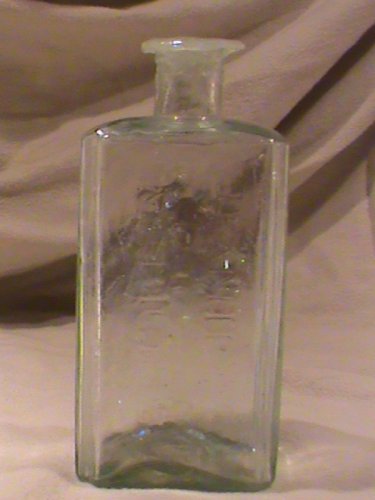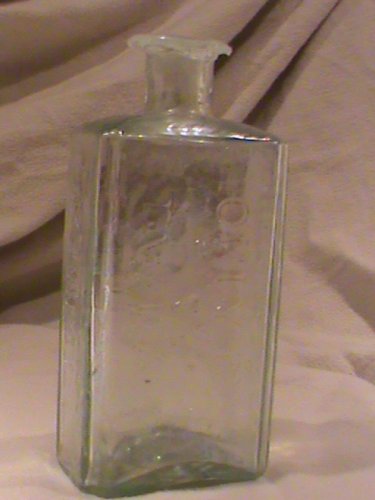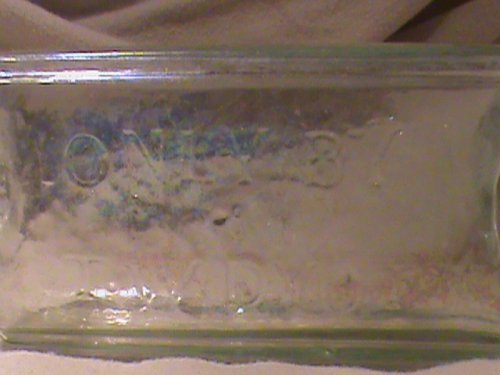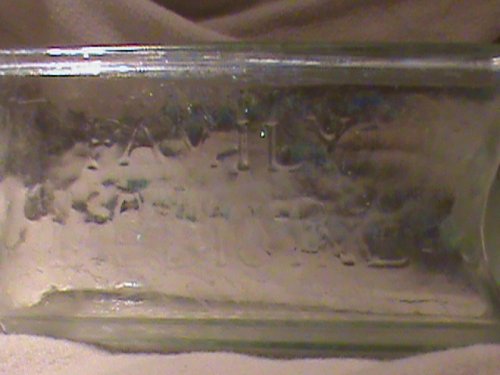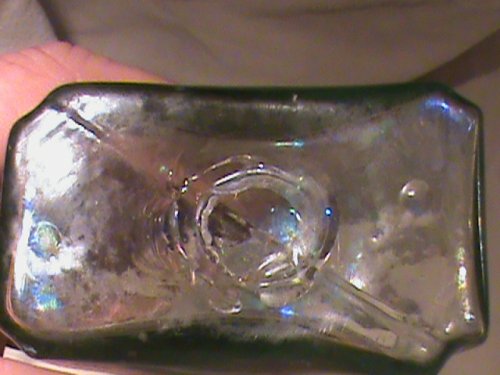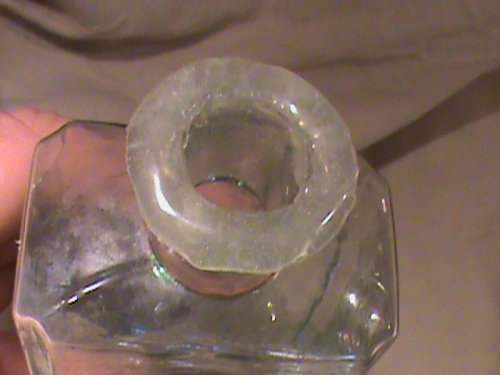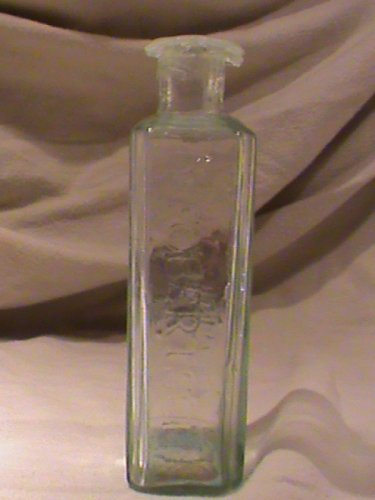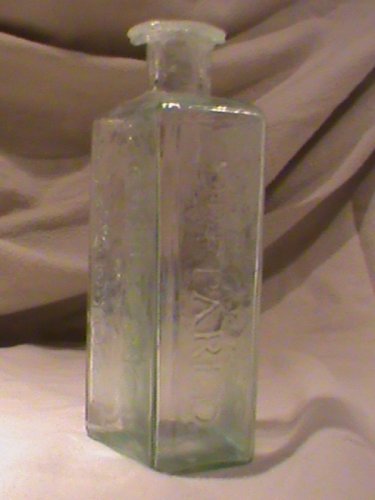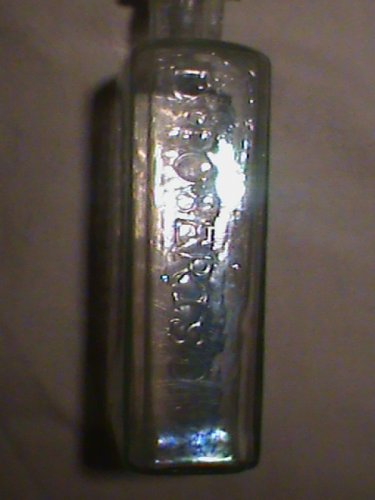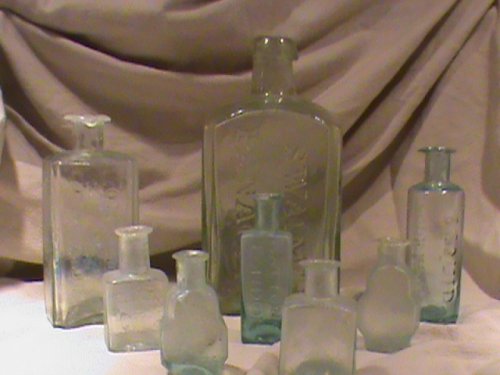Steve/sewell
Well-Known Member
- Joined
- Jan 23, 2010
- Messages
- 6,108
- Reaction score
- 5
- Points
- 0
DR. ROBERTSON’S FAMILY / MEDICINE/PREPARED /ONLY BY / T.W. DYOTT
Thank you Blade for a great bottle I received it at 1:00 PM today I cant thank you enough as I had been looking for one of these for four years now.I have had a lot of almosts only to be outbid in some outrageous bid battle.As Steve Martin once said.................Thank you, thank you, thank you, thank you,thank you, thank you, thank you,.I went right to work on the top taking Gunthers advice and using the Hxtal product.I think it came out Ok I give it a B.The original lip that was remaining was was still intact was turned down and sagged quite a bit from what a normal flared lip would look like. I left it on the bottle and worked around it .The area although rough looks like an in the making error.I was some what disappointed in the Hxtal product as it cured quickly with a slight chalky residue.I added a green dye to tint the apoxy.From the side it looks perfect it is just when it is viewed from directly overhead you can see the slight chalky whiteness to the glass.All in all I am very pleased and only plan to find a perfect one now.There are not too many of these around 10 or less telling me Dyott probably quickly switched to a paper only version to save cost.If these were mass produced and Dyott was the ultimate advertiser in his day one would think more of them would have been located by now.The other possibility was Dyott had different versions of his Dr. Robertson's nostrums and these early bottles were only around for a year or two carrying the original recipe.Well here it is with it's new prosthetic top. I have taken these pictures with my older camera as my daughter borrowed mine this evening for a fundraser Gala so the quality is a little lacking.I have taken pictures of other early Medicines also Swaim's,Bears Oil,Turlingtons Balsam all made at the Stangers and then Carpenter and Heston and then Olive glass works in Glassboro New Jersey between 1776 and 1820.
From the book the Toadstool Millionaires.
Elisha Perkins was laying plans to patent his metallic tractors when, in the mid-1790's, there arrived on American shores from England a poor druggist's apprentice named Thomas W. Dyott. The young migrant settled in Philadelphia and began to earn his living at blacking shoes. By day Dyott applied the polish which by night he made, and he performed so conspicuously, doing his daubing in the wide window of his small shop, that he attracted attention.
Soon he was manufacturing more polish than he himself could daub on other men's boots. The surplus he sold to others. In time Dyott accumulated enough capital to undertake a larger venture. The field of enterprise he chose was patent medicines. At first he opened a store. Early in the new century he acquired a "warehouse." Before long he moved to an even larger establishment which he called the American Dispensatory. Early in his career as nostrum monger, Dyott had drawn on his experience as an apprentice pharmacist and had begun making his own brands of patent medicines. This new departure was a very shrewd move indeed .
That same wave of cultural nationalism that lifted Perkins' tractors to such a dizzy height launched many packaged nostrums, Dyott's among them, on less sensational but longer lasting careers.
Not all American entrants in the promising field of nostrum promotion were Lees. A man named Church, for example, coined a pretty phrase for his vegetable lotion: "Cream drawn from Violets and Milk from Roses!!" A man named Dyott surpassed all his rivals during the first generation and became the king of nostrum makers in the American republic.
At the start Dyott relied heavily on a compound for the cure of "a certain disease," but soon he was producing a long line of remedies similar to those of Richard and Michael Lee. Most of these creations bore the name of a Dr. Robertson.
This worthy, Dyott asserted in his advertising, was his own grandfather, a distinguished physician in Edinburgh. The enterprising editor of a Philadelphia medical journal, looking into the matter, discovered that there had been no noted Dr. Robertson in Edinburgh for nearly two centuries. This intelligence did not disturb Dyott in the least. He went on vending Robertson's Infallible Worm Destroying Lozenges and the other priceless preparations devised by his honored progenitor, and he made bold to claim a more lofty dignity himself, assuming the title of Doctor of Medicine and fabricating a tale of long experience as a physician in London, the West Indies, and Philadelphia.
Business boomed. Dr. Dyott's advertisements were displayed prominently in daily papers, of the Eastern cities and occupied columns of space in the rural weeklies of the hinterland. Better to service his far-flung market, Dyott established agencies in New York, Cincinnati, New Orleans, and other cities. His advertisements featured drawings of large Conestoga wagons being loaded from his capacious warehouses with nostrums for the South and West.
Besides his own brands, Dyott distributed the old English patent medicines, and the pills and potions of his rivals, among them the bilious pills of Samuel H. P. Lee.
As Thomas Dyott, early in his career, had expanded from blacking to nostrums, so later he enlarged his enterprises again and again.
Living in the day of a barter economy, the shrewd merchandiser accepted produce for patent medicines. Soon he was dealing in such things as tobacco and turpentine, peach brandy and rum, candles and castor oil. The scope of his nostrum sales required thousands of bottles, an article he had first required while vending blacking, so Dyott acquired, first, an interest in a glass works, and then full ownership of a large factory on the Delaware River near Philadelphia.
Dyott not only undercut the prices of imported British glassware, but soon was turning out the best grade of bottle glass in America.
One product of his factory, preserved in the Smithsonian Institution, was a double portrait flask, honoring those two distinguished adopted sons of Philadelphia, Benjamin Franklin and Thomas Dyott .
By the 1830's Dyott was living extravagantly on a princely income of $25,000 a year. His personal estate was said to be worth $250,000. He dressed oddly and drove about in style, with four horses attached to his elegant English coach and several outriders in attendance. A man with such expansive vision who had achieved so much was perhaps bound to fancy himself a humanitarian. A pioneer at price-cutting, Dyott had offered to sell his remedies to the "laboring poor at one-half the usual price." For his own laborers he sought to turn his factory into a sort of model community. Whatever the proportion of alcohol in his remedies, the nostrum king permitted no spirituous liquors in Dyottsville.
Confronted with this demand for heroism, many Americans responded with timidity. They eschewed the rugged regimen of regular doctors and listened to patent medicine vendors who promised them an easier way. A mild and pleasant mode of treatment was a stock appeal in nostrum advertising. Very early, promoters began to decry the excessive use of mercury. The rigorous "mercurial disease" was included in the long list of ailments that their remedies would cure, and they swore solemnly—whether it was true or not—that there was no calomel in their concoctions. Samuel Lee, Jr., boasted that Samuel H. P.'s bilious pills contained mercury whereas his own did not. Dyott's remedy for "a certain disease" was touted as non-mercurial. Indeed, according to a cynical observer, one requisite for the success of any patent medicine was for its maker to attack the brutal therapy of the regular doctor. The nostrum salesman must "pronounce the surgeon's lancet a Bowie or an Indian scalping-knife, and calomel equal in properties to a mixture of arsenic, cicuta, and verdigris."
During these same years common schooling was imparting the ability to read to an ever-greater proportion of the American populace. New England and New York began to provide free schooling to the children of the poor, and by 1860 the principle of educating the common man was well established in the North and West. Constantly diminishing was the number of humble citizens too illiterate to puzzle out the gory symptoms and the glorious cures described in plain blunt English by Thomas Dyott and his competitors .
Promotion was much more difficult than production. For every Thomas Dyott there were a hundred small proprietors who lacked a certain business acumen to enable them to push a small venture into an outstanding success. Some hopeful proprietors failed altogether.
Thomas Dyott was one of these giants, but the benevolent baron of Dyottsville suffered a sad fate. Once again branching out, he established a bank. Moved by the same philanthropy that had prompted his model factory, Dyott promised "to give to the meritorious working man the full legal interest which he ought always to obtain for his savings." But this laudable aim could not be long fulfilled. In 1837 financial disaster struck the nation, and panic engulfed the bank. To save his various holdings, Dyott parceled out his stock among relatives and took refuge in bankruptcy. Creditors persuaded Pennsylvania state officials to sue the nostrum maker for fraudulent insolvency. Dyott's conduct, the prosecuting attorney told the jury, could be summed up as "systematic wholesale cheating." After hearing the evidence, the jury agreed. The moral elevation and the virtuous habits Dyott had sought to inculcate in his employees did not save him. Nor did the fact that he had once given money to build a church. A man in his late sixties, Dyott was sentenced to from one to seven years at hard labor. He was pardoned before the expiration of his term .
Such a blow from fortune might have caused the one-time bootblack to wish that he had limited his sphere of business action to manufacturing patent medicines. This at least was safely within the law. It was to this more circumscribed career of nostrum vendor that Dyott returned after his release from prison. He had lost his throne as nostrum king and he did not win it back. His post-depression activities were restricted in size and geographical compass. But he did have time to acquire another modest fortune before he died, during his ninetieth year, in 1861.
Dyott's career spanned more than half a century, the years in which the native American nostrum trade became soundly established.
Material on Dyott is drawn from newspaper advertising and the following: Phila. Med. Museum, 6 (1809), 58-62, and ns 1 (1811), 52-56; Joseph W. England, ed., The First Century of the Philadelphia College of Pharmacy (Phila., 1922), 19; George S.
The Toadstool Millionaires: Chapter 1, 16/9/2006
Jonathan Waldo, Account Book, circa 1770-1790, Library of the Essex Institute, Salem, Mass.; Joseph D. Weeks, "Reports on the Manufacture of Glass," Report of the Manufactures of the United States at the Tenth Census (Wash., 1883), 81-82; Thomas W. Dyott, An Exposition of the System of Moral and Mental Labor, Established at the Glass Factory of Dyott8ville (Phila., 1833), in the Hist. Soc. of Penna.
The Toadstool Millionaires: Chapter 11, 23/5/2002
The medicine man had something to teach because he had operated in an economy of abundance almost from the start. Since sickness was well-nigh universal, the demand for his wares was potentially inexhaustible. But then, so also was the supply. At least from the days of the four Lees and Thomas Dyott, American production of proprietary remedies was off to a fast start. There was no end to the variety and quantity of ingredients available, and there were soon more pills and potions than Americans could swallow conveniently. The medicine man's key task quickly became not production but sales, the job of persuading ailing citizens to buy his particular brand from among the hun-dreds offered. Whether unscrupulous or self-deluded, nostrum makers set about this task with cleverness and zeal.
The first requirement for success in a competitive world, as Dyott and Swaim, Brandreth and Helmbold, were quick to realize, was: Be known. Unless the identity of the product was firmly fixed in the minds of those who might buy, there was no hope. This called for lavish advertising. Patent medicine men confronted the American citizen as he read his mail, as he perused the paper, as he strolled the streets, as he traversed the countryside. They devised schemes to slip up on him unaware -- the plain envelope, the fake news story. They struck not only slyly but often. One pill was advertised thirty-seven times in the same issue of a paper. Dr. Donald Kennedy's Medical Discovery and Dr. T. Felix Gourard's complexion cure were promoted, year in and year out, without the slightest change in copy, for over forty years .
The Toadstool Millionaires: Sources, 1/6/2002
My own previous writing on patent medicine history, which reappears in some measure in this book, includes: "Patent Medi-cines in the Early Nineteenth Century," The South Atlantic Quarterly, 48 (Oct. 1949), 557-65; "Patent Medicines: The Early Post-Frontier Phase," Journal of the Illinois State Historical Society, 46 (Autumn, 1953), 254-64; "The Origin of Patent Medicines in America," The Chemist and Druggist, 172 (Sep. 9, 1959), 9-16; "Patent Medicines: An Early Example of Competi-tive Marketing," Journal of Economic History, 20 (Dec. 1960), 648-56; and two articles written in collaboration with George B. Griffenhagen, entitled "Old English Patent Medicines in America," of which a summary version appeared in Chemist and Druggist, 167 (June 29, 1957), 714-22, and a longer version as Paper 10 in United States National Museum Bulletin 218, Contributions from the Museum of History and Technology, pub-lished by the Smithsonian Institution (Washington, 1959). Three articles were in press: "American Medical Quackery in the Age of the Common Man," The Mississippi Valley Historical Review; "Thomas W. Dyott-Pioneer Nostrum Promoter," Journal of the American Pharmaceutical Association (Practical Pharmacy Edition); and "Patent Medicines and Indians," The Emory University Quarterly.

Thank you Blade for a great bottle I received it at 1:00 PM today I cant thank you enough as I had been looking for one of these for four years now.I have had a lot of almosts only to be outbid in some outrageous bid battle.As Steve Martin once said.................Thank you, thank you, thank you, thank you,thank you, thank you, thank you,.I went right to work on the top taking Gunthers advice and using the Hxtal product.I think it came out Ok I give it a B.The original lip that was remaining was was still intact was turned down and sagged quite a bit from what a normal flared lip would look like. I left it on the bottle and worked around it .The area although rough looks like an in the making error.I was some what disappointed in the Hxtal product as it cured quickly with a slight chalky residue.I added a green dye to tint the apoxy.From the side it looks perfect it is just when it is viewed from directly overhead you can see the slight chalky whiteness to the glass.All in all I am very pleased and only plan to find a perfect one now.There are not too many of these around 10 or less telling me Dyott probably quickly switched to a paper only version to save cost.If these were mass produced and Dyott was the ultimate advertiser in his day one would think more of them would have been located by now.The other possibility was Dyott had different versions of his Dr. Robertson's nostrums and these early bottles were only around for a year or two carrying the original recipe.Well here it is with it's new prosthetic top. I have taken these pictures with my older camera as my daughter borrowed mine this evening for a fundraser Gala so the quality is a little lacking.I have taken pictures of other early Medicines also Swaim's,Bears Oil,Turlingtons Balsam all made at the Stangers and then Carpenter and Heston and then Olive glass works in Glassboro New Jersey between 1776 and 1820.
From the book the Toadstool Millionaires.
Elisha Perkins was laying plans to patent his metallic tractors when, in the mid-1790's, there arrived on American shores from England a poor druggist's apprentice named Thomas W. Dyott. The young migrant settled in Philadelphia and began to earn his living at blacking shoes. By day Dyott applied the polish which by night he made, and he performed so conspicuously, doing his daubing in the wide window of his small shop, that he attracted attention.
Soon he was manufacturing more polish than he himself could daub on other men's boots. The surplus he sold to others. In time Dyott accumulated enough capital to undertake a larger venture. The field of enterprise he chose was patent medicines. At first he opened a store. Early in the new century he acquired a "warehouse." Before long he moved to an even larger establishment which he called the American Dispensatory. Early in his career as nostrum monger, Dyott had drawn on his experience as an apprentice pharmacist and had begun making his own brands of patent medicines. This new departure was a very shrewd move indeed .
That same wave of cultural nationalism that lifted Perkins' tractors to such a dizzy height launched many packaged nostrums, Dyott's among them, on less sensational but longer lasting careers.
Not all American entrants in the promising field of nostrum promotion were Lees. A man named Church, for example, coined a pretty phrase for his vegetable lotion: "Cream drawn from Violets and Milk from Roses!!" A man named Dyott surpassed all his rivals during the first generation and became the king of nostrum makers in the American republic.
At the start Dyott relied heavily on a compound for the cure of "a certain disease," but soon he was producing a long line of remedies similar to those of Richard and Michael Lee. Most of these creations bore the name of a Dr. Robertson.
This worthy, Dyott asserted in his advertising, was his own grandfather, a distinguished physician in Edinburgh. The enterprising editor of a Philadelphia medical journal, looking into the matter, discovered that there had been no noted Dr. Robertson in Edinburgh for nearly two centuries. This intelligence did not disturb Dyott in the least. He went on vending Robertson's Infallible Worm Destroying Lozenges and the other priceless preparations devised by his honored progenitor, and he made bold to claim a more lofty dignity himself, assuming the title of Doctor of Medicine and fabricating a tale of long experience as a physician in London, the West Indies, and Philadelphia.
Business boomed. Dr. Dyott's advertisements were displayed prominently in daily papers, of the Eastern cities and occupied columns of space in the rural weeklies of the hinterland. Better to service his far-flung market, Dyott established agencies in New York, Cincinnati, New Orleans, and other cities. His advertisements featured drawings of large Conestoga wagons being loaded from his capacious warehouses with nostrums for the South and West.
Besides his own brands, Dyott distributed the old English patent medicines, and the pills and potions of his rivals, among them the bilious pills of Samuel H. P. Lee.
As Thomas Dyott, early in his career, had expanded from blacking to nostrums, so later he enlarged his enterprises again and again.
Living in the day of a barter economy, the shrewd merchandiser accepted produce for patent medicines. Soon he was dealing in such things as tobacco and turpentine, peach brandy and rum, candles and castor oil. The scope of his nostrum sales required thousands of bottles, an article he had first required while vending blacking, so Dyott acquired, first, an interest in a glass works, and then full ownership of a large factory on the Delaware River near Philadelphia.
Dyott not only undercut the prices of imported British glassware, but soon was turning out the best grade of bottle glass in America.
One product of his factory, preserved in the Smithsonian Institution, was a double portrait flask, honoring those two distinguished adopted sons of Philadelphia, Benjamin Franklin and Thomas Dyott .
By the 1830's Dyott was living extravagantly on a princely income of $25,000 a year. His personal estate was said to be worth $250,000. He dressed oddly and drove about in style, with four horses attached to his elegant English coach and several outriders in attendance. A man with such expansive vision who had achieved so much was perhaps bound to fancy himself a humanitarian. A pioneer at price-cutting, Dyott had offered to sell his remedies to the "laboring poor at one-half the usual price." For his own laborers he sought to turn his factory into a sort of model community. Whatever the proportion of alcohol in his remedies, the nostrum king permitted no spirituous liquors in Dyottsville.
Confronted with this demand for heroism, many Americans responded with timidity. They eschewed the rugged regimen of regular doctors and listened to patent medicine vendors who promised them an easier way. A mild and pleasant mode of treatment was a stock appeal in nostrum advertising. Very early, promoters began to decry the excessive use of mercury. The rigorous "mercurial disease" was included in the long list of ailments that their remedies would cure, and they swore solemnly—whether it was true or not—that there was no calomel in their concoctions. Samuel Lee, Jr., boasted that Samuel H. P.'s bilious pills contained mercury whereas his own did not. Dyott's remedy for "a certain disease" was touted as non-mercurial. Indeed, according to a cynical observer, one requisite for the success of any patent medicine was for its maker to attack the brutal therapy of the regular doctor. The nostrum salesman must "pronounce the surgeon's lancet a Bowie or an Indian scalping-knife, and calomel equal in properties to a mixture of arsenic, cicuta, and verdigris."
During these same years common schooling was imparting the ability to read to an ever-greater proportion of the American populace. New England and New York began to provide free schooling to the children of the poor, and by 1860 the principle of educating the common man was well established in the North and West. Constantly diminishing was the number of humble citizens too illiterate to puzzle out the gory symptoms and the glorious cures described in plain blunt English by Thomas Dyott and his competitors .
Promotion was much more difficult than production. For every Thomas Dyott there were a hundred small proprietors who lacked a certain business acumen to enable them to push a small venture into an outstanding success. Some hopeful proprietors failed altogether.
Thomas Dyott was one of these giants, but the benevolent baron of Dyottsville suffered a sad fate. Once again branching out, he established a bank. Moved by the same philanthropy that had prompted his model factory, Dyott promised "to give to the meritorious working man the full legal interest which he ought always to obtain for his savings." But this laudable aim could not be long fulfilled. In 1837 financial disaster struck the nation, and panic engulfed the bank. To save his various holdings, Dyott parceled out his stock among relatives and took refuge in bankruptcy. Creditors persuaded Pennsylvania state officials to sue the nostrum maker for fraudulent insolvency. Dyott's conduct, the prosecuting attorney told the jury, could be summed up as "systematic wholesale cheating." After hearing the evidence, the jury agreed. The moral elevation and the virtuous habits Dyott had sought to inculcate in his employees did not save him. Nor did the fact that he had once given money to build a church. A man in his late sixties, Dyott was sentenced to from one to seven years at hard labor. He was pardoned before the expiration of his term .
Such a blow from fortune might have caused the one-time bootblack to wish that he had limited his sphere of business action to manufacturing patent medicines. This at least was safely within the law. It was to this more circumscribed career of nostrum vendor that Dyott returned after his release from prison. He had lost his throne as nostrum king and he did not win it back. His post-depression activities were restricted in size and geographical compass. But he did have time to acquire another modest fortune before he died, during his ninetieth year, in 1861.
Dyott's career spanned more than half a century, the years in which the native American nostrum trade became soundly established.
Material on Dyott is drawn from newspaper advertising and the following: Phila. Med. Museum, 6 (1809), 58-62, and ns 1 (1811), 52-56; Joseph W. England, ed., The First Century of the Philadelphia College of Pharmacy (Phila., 1922), 19; George S.
The Toadstool Millionaires: Chapter 1, 16/9/2006
Jonathan Waldo, Account Book, circa 1770-1790, Library of the Essex Institute, Salem, Mass.; Joseph D. Weeks, "Reports on the Manufacture of Glass," Report of the Manufactures of the United States at the Tenth Census (Wash., 1883), 81-82; Thomas W. Dyott, An Exposition of the System of Moral and Mental Labor, Established at the Glass Factory of Dyott8ville (Phila., 1833), in the Hist. Soc. of Penna.
The Toadstool Millionaires: Chapter 11, 23/5/2002
The medicine man had something to teach because he had operated in an economy of abundance almost from the start. Since sickness was well-nigh universal, the demand for his wares was potentially inexhaustible. But then, so also was the supply. At least from the days of the four Lees and Thomas Dyott, American production of proprietary remedies was off to a fast start. There was no end to the variety and quantity of ingredients available, and there were soon more pills and potions than Americans could swallow conveniently. The medicine man's key task quickly became not production but sales, the job of persuading ailing citizens to buy his particular brand from among the hun-dreds offered. Whether unscrupulous or self-deluded, nostrum makers set about this task with cleverness and zeal.
The first requirement for success in a competitive world, as Dyott and Swaim, Brandreth and Helmbold, were quick to realize, was: Be known. Unless the identity of the product was firmly fixed in the minds of those who might buy, there was no hope. This called for lavish advertising. Patent medicine men confronted the American citizen as he read his mail, as he perused the paper, as he strolled the streets, as he traversed the countryside. They devised schemes to slip up on him unaware -- the plain envelope, the fake news story. They struck not only slyly but often. One pill was advertised thirty-seven times in the same issue of a paper. Dr. Donald Kennedy's Medical Discovery and Dr. T. Felix Gourard's complexion cure were promoted, year in and year out, without the slightest change in copy, for over forty years .
The Toadstool Millionaires: Sources, 1/6/2002
My own previous writing on patent medicine history, which reappears in some measure in this book, includes: "Patent Medi-cines in the Early Nineteenth Century," The South Atlantic Quarterly, 48 (Oct. 1949), 557-65; "Patent Medicines: The Early Post-Frontier Phase," Journal of the Illinois State Historical Society, 46 (Autumn, 1953), 254-64; "The Origin of Patent Medicines in America," The Chemist and Druggist, 172 (Sep. 9, 1959), 9-16; "Patent Medicines: An Early Example of Competi-tive Marketing," Journal of Economic History, 20 (Dec. 1960), 648-56; and two articles written in collaboration with George B. Griffenhagen, entitled "Old English Patent Medicines in America," of which a summary version appeared in Chemist and Druggist, 167 (June 29, 1957), 714-22, and a longer version as Paper 10 in United States National Museum Bulletin 218, Contributions from the Museum of History and Technology, pub-lished by the Smithsonian Institution (Washington, 1959). Three articles were in press: "American Medical Quackery in the Age of the Common Man," The Mississippi Valley Historical Review; "Thomas W. Dyott-Pioneer Nostrum Promoter," Journal of the American Pharmaceutical Association (Practical Pharmacy Edition); and "Patent Medicines and Indians," The Emory University Quarterly.


